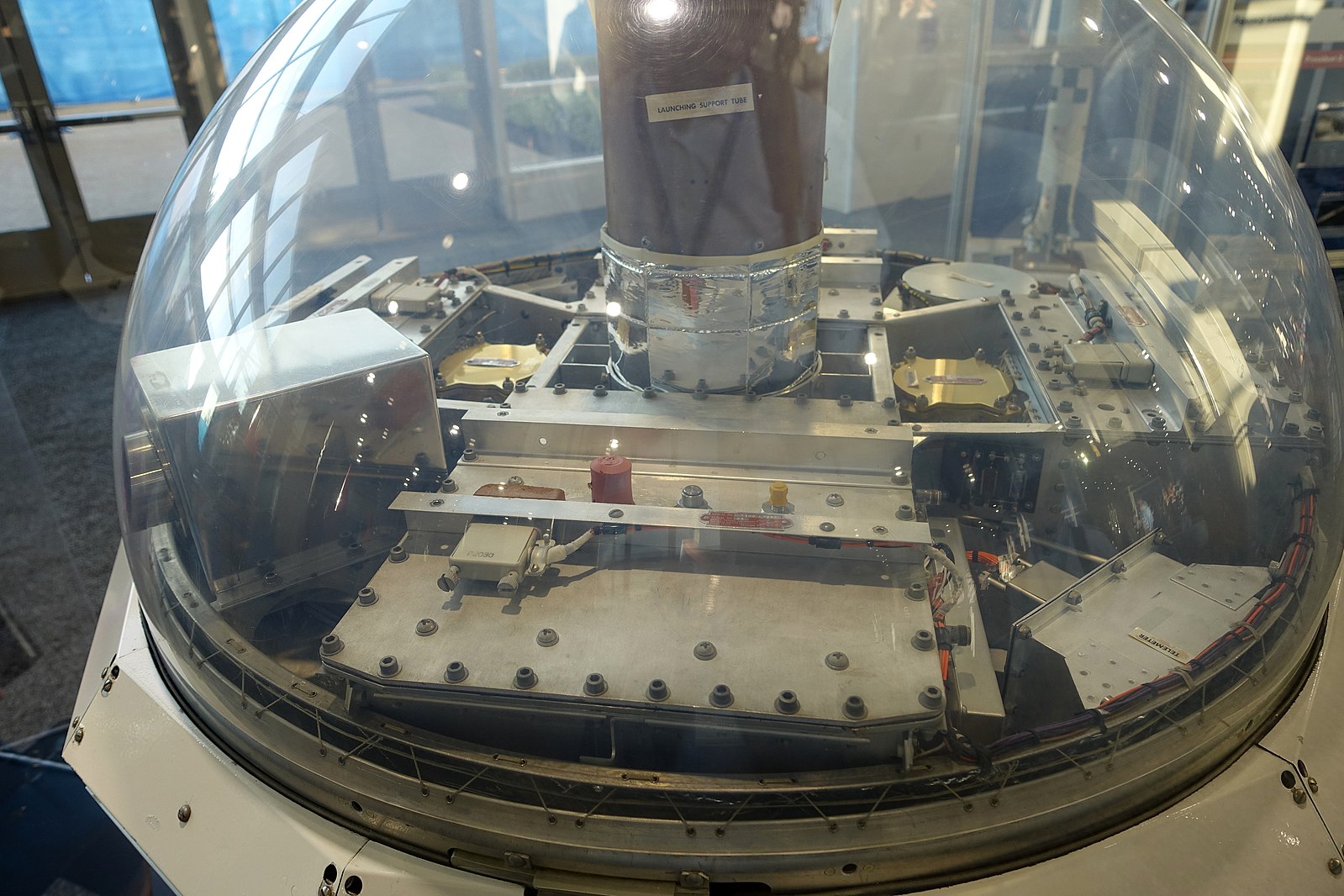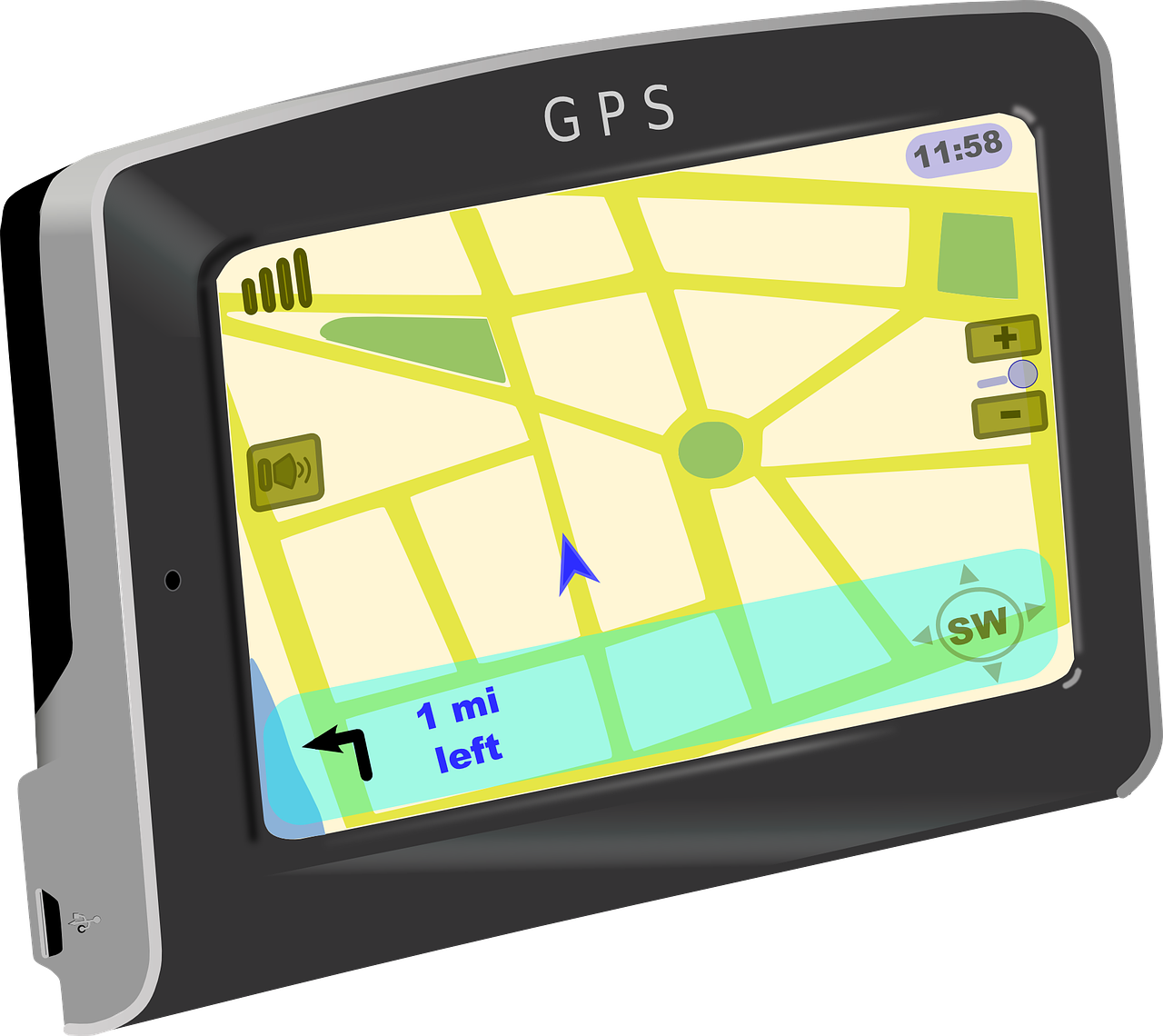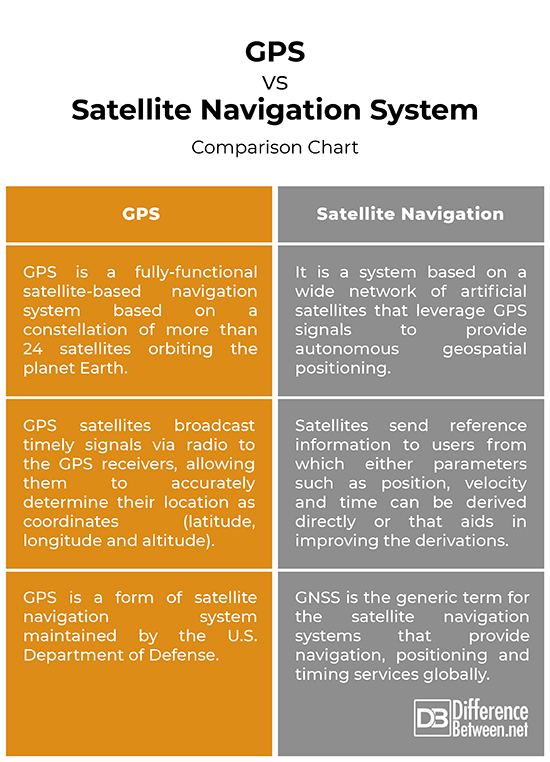Difference Between GPS and Satellite Navigation System
• Categorized under Technology | Difference Between GPS and Satellite Navigation System
It is remarkable how far we have come with navigation since the early days of navigation when getting from point A to point B was based on celestial navigation using observations of the positions of Sun, Moon and stars. Early explorers used to determine the positions of points on the Earth’s surface using observations of distant objects. The early navigation tools such as the compass has been the most used navigation tool for hundreds of years, along with hourglass, quadrant, and astrolabe. But with the advent of technological evolution and with the dawning of the space age, the need to develop a global navigation system for better positioning and navigation was imminent. Over the years, several radio systems were developed for satellite tracking and orbit determination. A new satellite-based navigation system was developed in the early 1970s called the Global Positioning System (GPS) which has revolutionized navigation. GPS has evolved since then and now GPS technology is used around the world from mobile phones to car navigation systems.
What is Satellite Navigation?
Satellite navigation is a system based on a wide network of artificial satellites that transmit radio signals in medium earth orbit. The main objective of satellite navigation is to provide autonomous geospatial positioning. Navigation is the art of getting from one point to another following the most suitable direction possible. The art of navigation has been there since prehistoric times. Time has changed and we have moved from the traditional navigation tools to the modern-day satellite navigation systems. In satellite based navigation system, the signals transmitted from navigation satellites are used to determine the required set of position parameters by a navigation receiver. There parameters are then used to decide the course of movement. From the sixteenth century, navigation witnessed a rapid development in related technology when new instruments and techniques were discovered.
What is GPS?
GPS, short for Global Positioning System, is a fully-functional satellite-based navigation system based on a constellation of more than 24 satellites orbiting the planet Earth. This constellation of satellites, known as the initial operational capability (IOC), was completed in July 1993. To ensure worldwide coverage, GPS satellites are arranged so that four satellites are placed in each of six orbital planes. They broadcast timely signals via radio to the GPS receivers, allowing them to accurately determine their location as coordinates (latitude, longitude and altitude), day and night, regardless of the weather conditions. GPS was initially developed by the U.S. Department of Defense (DoD) in the early 1970s as a military system to fulfill U.S. military needs. But over time, the technology has become a global utility, indispensable for modern navigation and positioning on land, air and sea. In addition, GPS is also a great tool for land-surveying and map-making.
Difference between GPS and Satellite Navigation System
Definition of GPS and Satellite Navigation System
– Satellite navigation is a system based on a wide network of artificial satellites that send reference information to users from which either the navigational parameters, such as position, velocity and time, can be derived directly or that aids in improving the derivations. It makes use of GPS signals to provide autonomous geospatial positioning. GPS (short for Global Positioning System) is a fully-functional satellite-based navigation system based on a constellation of more than 24 satellites orbiting the planet Earth. They broadcast timely signals via radio to the GPS receivers, allowing them to accurately determine their location as coordinates (latitude, longitude and altitude).
System
– The idea behind GPS is very simple. GPS satellites transmit continuous microwave radio signals composed of two carriers, two codes and a navigation message. These signals are picked up the GPS receiver and once the receiver acquires the signal, it processes the signal using its built-in software. The partial outcome of the signal processing consists of the distances to the GPS satellites through the digital codes and the navigation message contains the coordinates of the satellites. GNSS, short for Global Navigation Satellite System, is the generic term for the satellite-based navigation systems to describe any constellation of satellites that provide navigation, positioning and timing services globally.
Applications of GPS and Satellite Navigation System
– Like any other forms of navigation, the position, velocity and time estimates obtained from the satellite navigation system can be used in a multitude of applications, ranging from personal navigation purposes to cars and mobile GPS systems, banking systems, energy distribution, providing time and frequency synchronizations. Satellite navigation systems help us to drive across unknown roads, whether by land, sea or air, find the nearest Starbucks, and much more. GPS is a form of satellite navigation system maintained by the U.S. DoD and GPS systems can be found in almost any industrial sector as well as used for military applications for vehicle navigation, logistical support, etc.
GPS vs. Satellite Navigation System: Comparison Chart
Summary of GPS vs. Satellite Navigation System
Satellite navigation has become a fundamental part of our daily lives. It is not only being used for personal navigation purposes, in cars and smartphones to determine positions, but it also becoming of great use in industrial sectors like banking systems, farming, energy distribution networks, providing time and frequency synchronizations. GNSS is the generic term for the satellite navigation systems that provide navigation, positioning and timing services globally. It has become a mainstay of transportation systems, providing navigation for ground, aviation and maritime operations. GPS is the most active and widely used GNSS in operation, along with the Russian GLONASS, European Galileo, and the Chinese BeiDou Navigation Satellite System (BDS).
Outside his professional life, Sagar loves to connect with people from different cultures and origin. You can say he is curious by nature. He believes everyone is a learning experience and it brings a certain excitement, kind of a curiosity to keep going. It may feel silly at first, but it loosens you up after a while and makes it easier for you to start conversations with total strangers – that’s what he said."
- Difference Between Caucus and Primary - June 18, 2024
- Difference Between PPO and POS - May 30, 2024
- Difference Between RFID and NFC - May 28, 2024
Sharing is caring!
Search DifferenceBetween.net :
Cite
APA 7
Khillar, S. (2020, January 6). Difference Between GPS and Satellite Navigation System. Difference Between Similar Terms and Objects. http://www.differencebetween.net/technology/difference-between-gps-and-satellite-navigation-system/.
MLA 8
Khillar, Sagar. "Difference Between GPS and Satellite Navigation System." Difference Between Similar Terms and Objects, 6 January, 2020, http://www.differencebetween.net/technology/difference-between-gps-and-satellite-navigation-system/.
Leave a Response
Written by : Sagar Khillar. and updated on 2020, January 6
References :
[0]Image credit: https://pixabay.com/de/vectors/gps-navigation-garmin-ger%C3%A4t-l%C3%A4nge-304842/
[1]Image credit: https://commons.wikimedia.org/wiki/File:Transit_satellite_navigation_system_-_D60_Symposium_-_Defense_Advanced_Research_Projects_Agency_-_DSC05550.jpg
[2]Teunissen, Peter and Oliver Montenbruck. Springer Handbook of Global Navigation Satellite Systems. Berlin, Germany: Springer, 2017. Print
[3]Re, Enrico and Marina Ruggieri. Satellite Communications and Navigation Systems. Berlin, Germany: Springer, 2007. Print
[4]El-Rabbany, Ahmed. Introduction to GPS: The Global Positioning System. Norwood, Massachusetts: Artech House, 2002. Print
[5]Acharya, Rajat. Understanding Satellite Navigation. Amsterdam, Netherlands: Academic Press, 2014. Print
See more about : GPS, Satellite Navigation System



